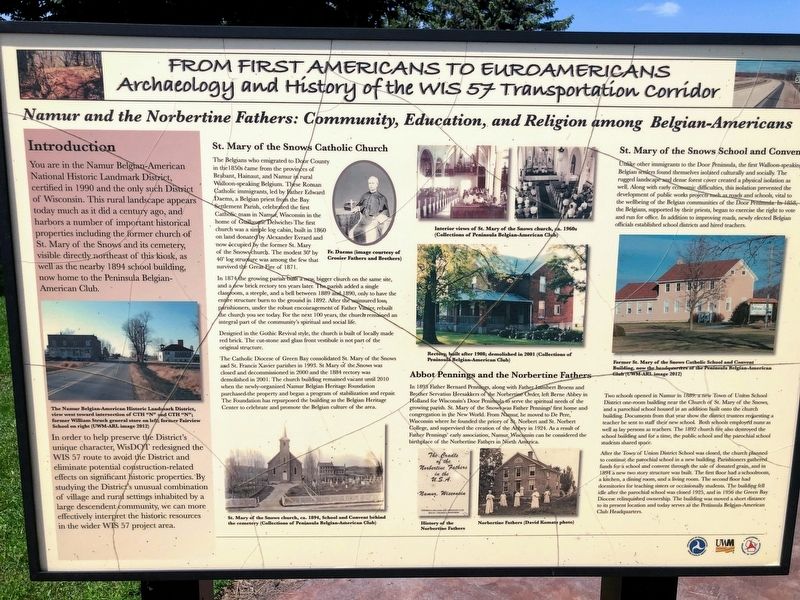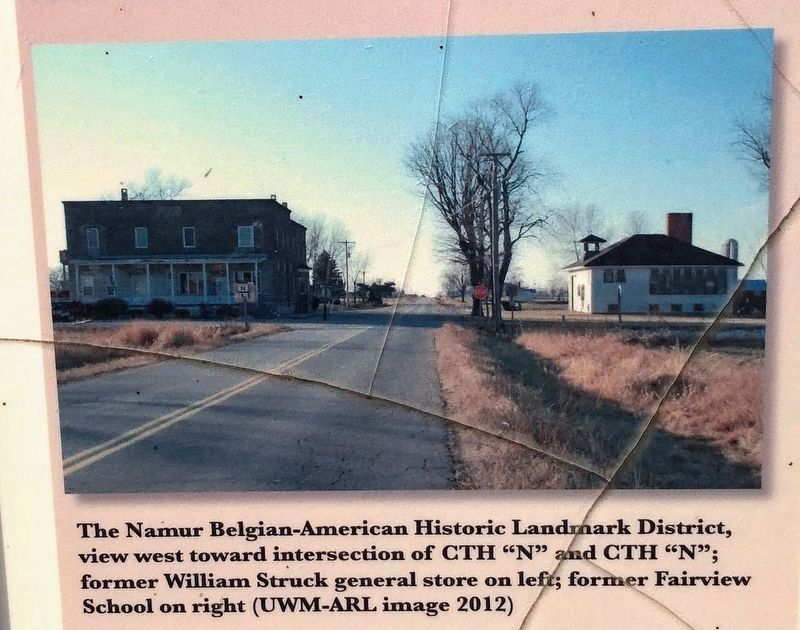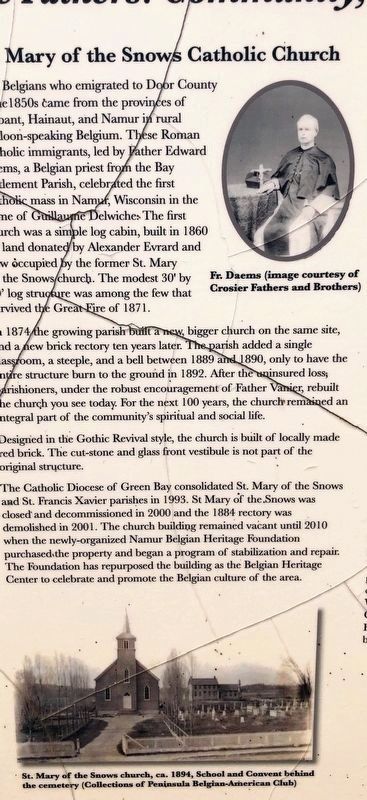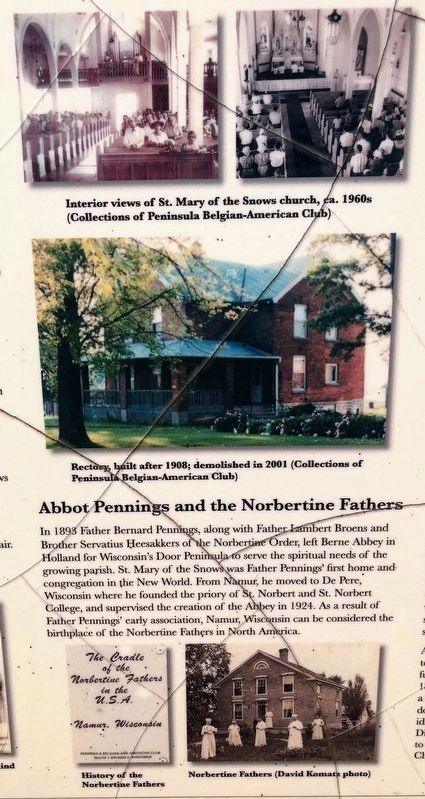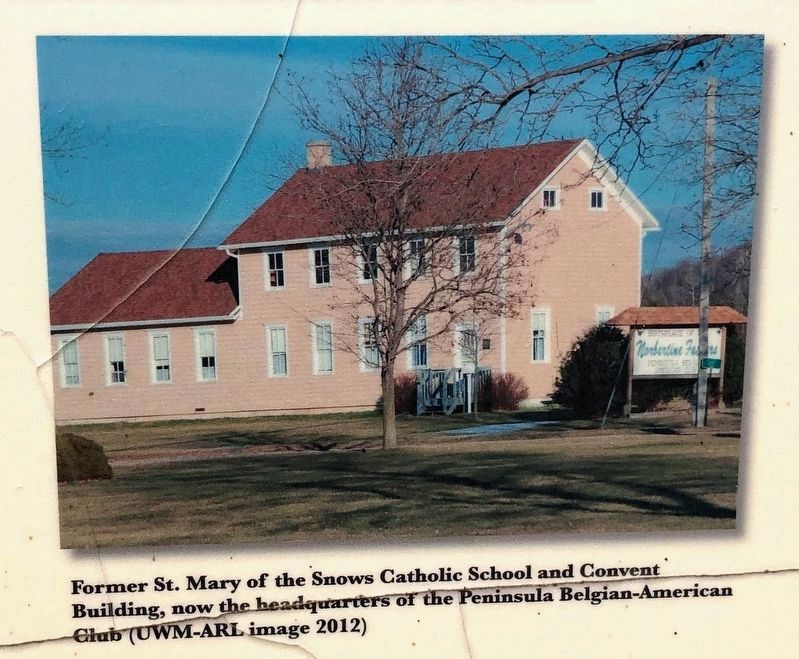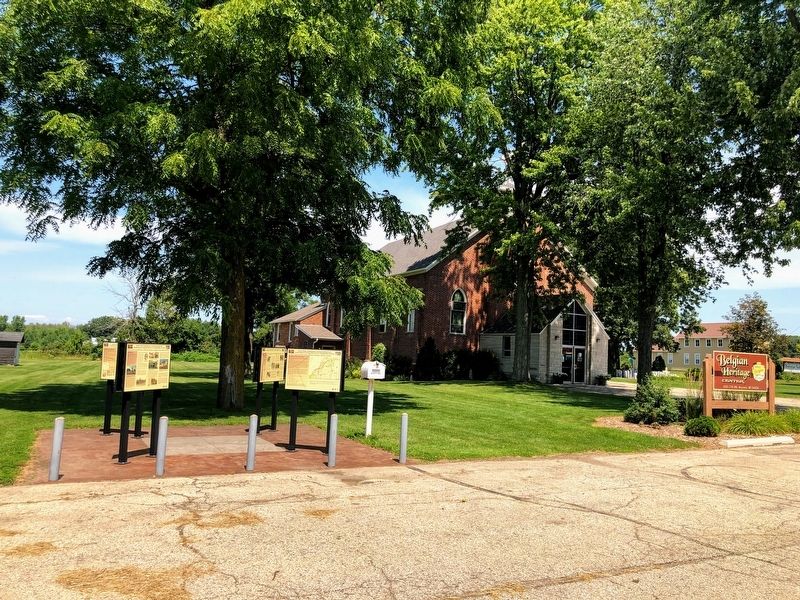Namur and the Norbertine Fathers: Community, Education, and Religion among Belgian-Americans
From First Americans to Euroamericans
— Archaeology and History of the WIS 57 Transportation Corridor —
You are in the Namur Belgian-American National Historic Landmark District, certified in 1900 and the only such District of Wisconsin. This rural landscape appears today much as it did a century ago, and harbors a number of important historical properties including the former church of St. Mary of the Snows and its cemetery, visible directly northeast of this kiosk, as well as the nearby 1894 school building, now home to the Peninsula Belgian-American Club.
In order to help preserve the District's unique character, WisDOT redesigned the WIS 57 route to avoid the District and eliminate potential construction-related effects on significant historic properties. By studying the District's unusual combination of village and rural settings inhabited by a large descendent community, we can more effectively interpret the historic resources in the wider WIS 57 project area.
St. Mary of the Snows Catholic Church
The Belgians who emigrated to Door County in the 1850s came from the provinces of Brabant, Hainaut, and Namur in rural Walloon-speaking Belgium. These Roman Catholic immigrants, led by Father Edward Daems, a Belgian priest from the Bay Settlement Parish, celebrated the first Catholic mass in Namur, Wisconsin in the home of Guilluame Delwiche. The first church was a simple log cabin, built
In 1874 the growing parish built a new, bigger church on the same site, and a new brick rectory ten years later. The parish added a single classroom, a steeple, and a bell between 1889 and 1890, only to have the entire structure burn to the ground in 1892. After the uninsured loss, parishioners, under the robust encouragement of Father Vanier, rebuilt the church you see today. For the next 100 years, the church remained an integral part of the community's spiritual and social life.
Designed in the Gothic Revival style, the church is built of locally made red brick. The cut-stone and glass front vestibule is not part of the original structure.
The Catholic Diocese of Green Bay consolidated St. Mary of the Snows and St. Francis Xavier parishes in 1993. St. Mary of the Snows was closed and decommissioned in 2000 and the 1884 rectory was demolished in 2001. The church building remained vacant until 2010 when the newly-organized Namur Belgian Heritage Foundation purchased the property and began a program of stabilization and repair. The Foundation has repurposed the building as the Belgian Heritage Center to celebrate and promote the Belgian culture of the area.
Abbot Pennings and the Norbertine Fathers
In 1893 Father Bernard Pennings, along with Father Lambert Broens and Brother Servatius Heesakkers of the Norbertine Order, left Berne Abbey in Holland for Wisconsin's Door Peninsula to serve the spiritual needs of the growing parish. St. Mary of the Snows was Father Pennings' first home and congregation in the New World. From Namur, he moved to De Pere, Wisconsin where he founded the priory of St. Norbert and St. Norbert College, and supervised the creation of the Abbey in 1924. As a result of Father Pennings' early association, Namur, Wisconsin can be considered the birthplace of the Norbertine Fathers in North America.
St. Mary of the Snows School and Convent
Unlike other immigrants to the Door Peninsula, the first Walloon-speaking Belgian settlers found themselves isolated culturally and socially. The rugged landscape and dense forest cover created a physical isolation as well. Along with early economic difficulties, this isolation prevented the development of public works projects such as roads and schools, vital to the wellbeing of the Belgian communities of the Door Peninsula. In 1858, the Belgians, supported by their priests, began to exercise the right to vote and run for office. In addition to improving roads, newly elected Belgian officials established school districts and hired teachers.
Two schools
opened in Namur in 1889: a new Town of Union School District one-room building near the Church of St. Mary of the Snows, and a parochial school housed in an addition built onto the church building. Documents from that year show the district trustees requesting a teacher be sent to staff their new school. Both schools employed nuns as well as lay persons as teachers. The 1892 church fire also destroyed the school building and for a time, the public school and the parochial school students shared space.
After the Town of Union District School was closed, the church planned to continue the parochial school in a new building. Parishioners gathered funds for a school and convent through the sale of donated grain, and in 1894 a new two story structure was built. The first floor had a schoolroom, a kitchen, a dining room, and a living room. The second floor had dormitories for teaching sisters or occasionally students. The building fell idle after the parochial school was closed in 1925, and in 1956 the Green Bay Diocese relinquished ownership. The building was moved a short distance to its present location and today serves as the Peninsula Belgian-American Club Headquarters.
Erected by U.S. Department of Transportation, University of Wisconsin–Milwaukee, Wisconsin Department of Transportation.
Topics. This historical marker is listed
Location. 44° 44.063′ N, 87° 40.019′ W. Marker is in Namur, Wisconsin, in Door County. Marker is on County Road DK, 0.1 miles east of County Road N, on the right when traveling west. Touch for map. Marker is at or near this postal address: 1255 County Road DK, Brussels WI 54204, United States of America. Touch for directions.
Other nearby markers. At least 8 other markers are within 3 miles of this marker, measured as the crow flies. Architecture and History in the WIS 57 Project Area (here, next to this marker); Transportation Archaeology on the WIS 57 Project (here, next to this marker); The WIS 57 Reconstruction Project in Brown, Kewaunee, and Door Counties (here, next to this marker); Historic Euroamerican Settlement of the Door Peninsula (here, next to this marker); After the Fire: The Vandermissen Brickworks Site (here, next to this marker); The Fire of 1871 and Williamsonville: A 19th Century Euroamerican Settlement in Door County (here, next to this marker); Belgian Settlement in Wisconsin (within shouting distance of this marker); The Brussels Cemetery Grotto (approx. 2˝ miles away). Touch for a list and map of all markers in Namur.
More about this marker. The marker is part of the "From First Americans to Euroamericans" marker group.
Also see . . . Namur Belgian-American District National Register Nomination. (Submitted on January 21, 2020, by William Fischer, Jr. of Scranton, Pennsylvania.)
Credits. This page was last revised on June 14, 2020. It was originally submitted on January 18, 2020, by Devon Polzar of Port Washington, Wisconsin. This page has been viewed 325 times since then and 31 times this year. Last updated on February 28, 2020, by Devon Polzar of Port Washington, Wisconsin. Photos: 1, 2, 3, 4, 5, 6. submitted on January 18, 2020, by Devon Polzar of Port Washington, Wisconsin. • Mark Hilton was the editor who published this page.
